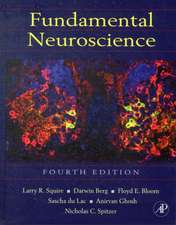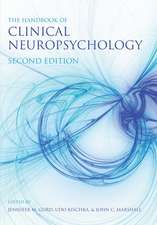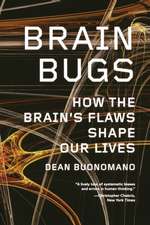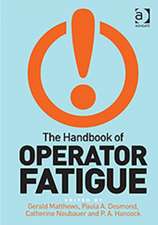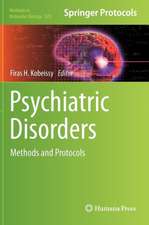Neuron-Glia Interaction in Neuroinflammation: Advances in Neurobiology, cartea 7
Editat de Akio Suzumura, Kazuhiro Ikenakaen Limba Engleză Hardback – 14 sep 2013
| Toate formatele și edițiile | Preț | Express |
|---|---|---|
| Paperback (1) | 1103.31 lei 6-8 săpt. | |
| Springer – 23 aug 2016 | 1103.31 lei 6-8 săpt. | |
| Hardback (1) | 1111.53 lei 6-8 săpt. | |
| Springer – 14 sep 2013 | 1111.53 lei 6-8 săpt. |
Din seria Advances in Neurobiology
- 18%
 Preț: 1115.14 lei
Preț: 1115.14 lei - 18%
 Preț: 1384.26 lei
Preț: 1384.26 lei - 18%
 Preț: 1385.85 lei
Preț: 1385.85 lei - 18%
 Preț: 1847.84 lei
Preț: 1847.84 lei - 18%
 Preț: 960.42 lei
Preț: 960.42 lei - 15%
 Preț: 645.79 lei
Preț: 645.79 lei - 18%
 Preț: 960.93 lei
Preț: 960.93 lei - 18%
 Preț: 1229.10 lei
Preț: 1229.10 lei - 18%
 Preț: 950.33 lei
Preț: 950.33 lei - 18%
 Preț: 1671.09 lei
Preț: 1671.09 lei - 18%
 Preț: 1116.71 lei
Preț: 1116.71 lei - 18%
 Preț: 959.98 lei
Preț: 959.98 lei - 18%
 Preț: 955.08 lei
Preț: 955.08 lei - 18%
 Preț: 948.79 lei
Preț: 948.79 lei - 18%
 Preț: 1230.66 lei
Preț: 1230.66 lei - 15%
 Preț: 648.42 lei
Preț: 648.42 lei - 18%
 Preț: 1010.17 lei
Preț: 1010.17 lei - 24%
 Preț: 897.50 lei
Preț: 897.50 lei - 18%
 Preț: 964.23 lei
Preț: 964.23 lei - 18%
 Preț: 945.47 lei
Preț: 945.47 lei - 18%
 Preț: 1222.69 lei
Preț: 1222.69 lei - 15%
 Preț: 641.38 lei
Preț: 641.38 lei - 18%
 Preț: 1222.31 lei
Preț: 1222.31 lei - 18%
 Preț: 1227.21 lei
Preț: 1227.21 lei - 18%
 Preț: 1843.91 lei
Preț: 1843.91 lei - 18%
 Preț: 1231.01 lei
Preț: 1231.01 lei - 18%
 Preț: 1111.97 lei
Preț: 1111.97 lei - 24%
 Preț: 957.43 lei
Preț: 957.43 lei - 18%
 Preț: 1228.62 lei
Preț: 1228.62 lei - 18%
 Preț: 1124.47 lei
Preț: 1124.47 lei - 18%
 Preț: 1394.38 lei
Preț: 1394.38 lei - 18%
 Preț: 1227.67 lei
Preț: 1227.67 lei - 18%
 Preț: 1263.82 lei
Preț: 1263.82 lei - 5%
 Preț: 1637.00 lei
Preț: 1637.00 lei - 18%
 Preț: 948.92 lei
Preț: 948.92 lei
Preț: 1111.53 lei
Preț vechi: 1355.52 lei
-18% Nou
Puncte Express: 1667
Preț estimativ în valută:
212.72€ • 230.98$ • 178.68£
212.72€ • 230.98$ • 178.68£
Carte tipărită la comandă
Livrare economică 23 aprilie-07 mai
Preluare comenzi: 021 569.72.76
Specificații
ISBN-13: 9781461483120
ISBN-10: 1461483123
Pagini: 200
Ilustrații: X, 187 p. 25 illus., 24 illus. in color.
Dimensiuni: 155 x 235 x 17 mm
Greutate: 0.52 kg
Ediția:2013
Editura: Springer
Colecția Springer
Seria Advances in Neurobiology
Locul publicării:New York, NY, United States
ISBN-10: 1461483123
Pagini: 200
Ilustrații: X, 187 p. 25 illus., 24 illus. in color.
Dimensiuni: 155 x 235 x 17 mm
Greutate: 0.52 kg
Ediția:2013
Editura: Springer
Colecția Springer
Seria Advances in Neurobiology
Locul publicării:New York, NY, United States
Public țintă
ResearchCuprins
Acute, Chronic, and Non-classical Neuroinflammation: Definitions in a Changing Scientific Environment.- Neuroinflammation in Neurological Disorders.- Factors from Intact and Damaged Neurons.- Interactions between Neurons and Microglia During Neuroinflammation.- Neuron-Astrocyte Interactions in Neuroinflammation.- Neuron-oligodendrocyte Interactions in Neuroinflammation.- Neuron-glia Interaction via Neurotrophins.- Glial Communication via Gap Junction in Neuroinflammation.- Toll-Like Receptors and Neuroinflammation.- The Blood-Brain-Barrier in Neuroinflammation.
Recenzii
From the reviews:
“This is a good text concerning the inflammatory neurotoxic and neuroprotective roles of the molecular mediators associated with stroke, ALS, MS, Alzheimer’s, and other neurological diseases. … I recommend this book for immunologists, neurologists and neuroscience graduate students.” (Joseph J. Grenier, Amazon.com, June, 2014)
“This is a good text concerning the inflammatory neurotoxic and neuroprotective roles of the molecular mediators associated with stroke, ALS, MS, Alzheimer’s, and other neurological diseases. … I recommend this book for immunologists, neurologists and neuroscience graduate students.” (Joseph J. Grenier, Amazon.com, June, 2014)
Notă biografică
Akio Suzumura, MD, PhD, graduated from Gifu University, School of Medicine in 1975. After getting PhD degree at Department Neurology, Nagoya University, School of Medicine in 1983, he had worked for Department of Neurology, University of Pennsylvania as a post-doctoral fellow until 1987. There, he established the methods for isolation of oligodendrocytes and microglia and had studied immunological functions of glial cells. He became an assistant professor in Department of Neurology, Fujita Health University in 1987, and an associate professor in Department of Neurology, Nara Medical University in 1995. He became Professor and Chairman in Department of Neuroimmunology, Research Institute of Environmental Medicine, Nagoya University in 2001, and currently a vise president of the Institute. He had been a president of Japanese Society of Neuroimmunolgy (2008-2012). He is currently an Editor-in-Chief of Clinical and Experimental Neuroimmunology, an Academic Editor of PLoS ONE. His current interest is neuron-glia interactions in both physiological and pathological conditions.
Dr. Kazuhiro Ikenaka is Professor at the National Institute for Physiological Sciences in Okazaki, Japan since 1992. He graduated from Osaka University, Faculty of Science majoring in Biochemistry. His current research interest is in glial biology. He is studying the development of glial cells (oligodendrocyte and astrocyte) and their function in the adult brain. He is also interested in pathophysiology of demyelinating diseases, especially multiple sclerosis. He developed a sensitive way to analyze N-linked sugar chain structure and is willing to find a new function of N-glycans in glial cells. He is currently an Associate Editor of Journal of Neuroscience Research, Neurochemical Research, and Developmental Neuroscience, and Senior Editor for ASN Neuro.
Dr. Kazuhiro Ikenaka is Professor at the National Institute for Physiological Sciences in Okazaki, Japan since 1992. He graduated from Osaka University, Faculty of Science majoring in Biochemistry. His current research interest is in glial biology. He is studying the development of glial cells (oligodendrocyte and astrocyte) and their function in the adult brain. He is also interested in pathophysiology of demyelinating diseases, especially multiple sclerosis. He developed a sensitive way to analyze N-linked sugar chain structure and is willing to find a new function of N-glycans in glial cells. He is currently an Associate Editor of Journal of Neuroscience Research, Neurochemical Research, and Developmental Neuroscience, and Senior Editor for ASN Neuro.
Textul de pe ultima copertă
Accumulation of glia, gliosis, in various neurological disorders is not a static scar, but actively involved in pathogenesis of various neurological and psychiatric disorders, where glial cells produce both inflammatory and neurotrophic factors. These factors may play a role in neuronal damage, but also have a protective and reparative function by inducing neuroinflammation. However, definition as well as the mechanisms of neuroinflammation is not yet clear. We first define acute, chronic and non-classical neuroinflammation.
Glial cells are activated by a variety of stimuli via receptors on glial cells. Toll like receptors (TLR) are one of these receptors. In response to harmful stimuli, neurons produce factors as either “eat-me” or “help-me” signals. These factors include cytokines, chemokines and damage-associated molecular pattern (DAMP). Some of them activate glial cells via TLR, and function to protect neurons or further induce neuroinflammation. Thus, the interaction between neuron-glia and glia-glia is a main feature of neuroinflammation. Glial cells communicate with other glial or neural cells via gap-junctions. The communication may also be important for the understanding of neuroinflammation. Oligodendrocytes-neurons communication may be critical in either myelination or demyelination. Damage of blood-brain barrier (BBB) is common feature of both inflammatory and degenerative neurological disorders. Thus, relation of BBB damage and functions of glial cell may also be important in the development of neuroinflammation.
In this book, we focused on neuron-glia interaction of various aspects for understanding of pathophysiology of neuroinflammation in development of inflammatory as well as degenerative neurological disorders.
Glial cells are activated by a variety of stimuli via receptors on glial cells. Toll like receptors (TLR) are one of these receptors. In response to harmful stimuli, neurons produce factors as either “eat-me” or “help-me” signals. These factors include cytokines, chemokines and damage-associated molecular pattern (DAMP). Some of them activate glial cells via TLR, and function to protect neurons or further induce neuroinflammation. Thus, the interaction between neuron-glia and glia-glia is a main feature of neuroinflammation. Glial cells communicate with other glial or neural cells via gap-junctions. The communication may also be important for the understanding of neuroinflammation. Oligodendrocytes-neurons communication may be critical in either myelination or demyelination. Damage of blood-brain barrier (BBB) is common feature of both inflammatory and degenerative neurological disorders. Thus, relation of BBB damage and functions of glial cell may also be important in the development of neuroinflammation.
In this book, we focused on neuron-glia interaction of various aspects for understanding of pathophysiology of neuroinflammation in development of inflammatory as well as degenerative neurological disorders.
Caracteristici
Focuses on neuron-glia interaction of various aspects for understanding of neurological disorders Discusses interactions between neurons and microglia during neuroinflammation Written by experts in the field

